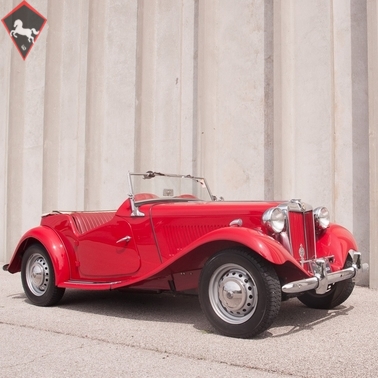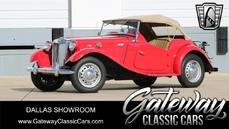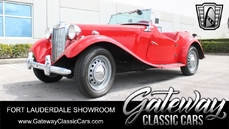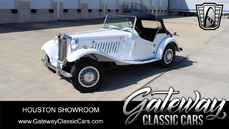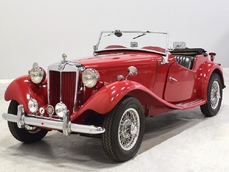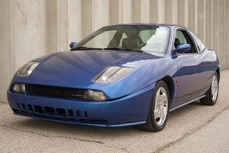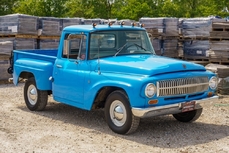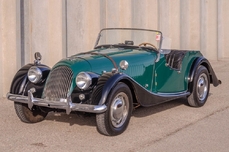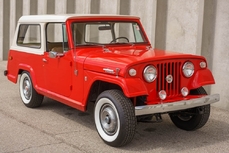MG TD 1.3L four-cylinder 1952
Allgemeine Beschreibung :
1952 MG TD Roadster
Same Virginia owner for 35 years!
One of 285 MG TDs exported to North America in 1952 out of 10,838 total 1952 models
1.3L XPAG four-cylinder engine #19834
Four-speed manual transmission
Stunning Red exterior with and red leather interior
Very nice paint, chrome and trim
White folding top and side curtains
Disc-type road wheels
The MG TD extended America’s Sports Car craze. This 1952 MG TD has been lovingly cared for by the same Virginia owner for the past 35 years and today it appears as a very stunning TD example!
Many servicemen stationed in England fell hard for the MG models they saw, rode in and owned while in Europe. This particular example was built on September 2, 1952 at MG’s factory in Abingdon, Oxfordshire, England.
Dressed in MG Red, this car’s paint and trim are in overall excellent order, reflecting its previous owner’s long-term care and the paint shines brilliantly in person. The contrasting white, folding top and side curtains are in good, original condition.
The car’s body is straight and solid, its chrome bumperettes and bumper guards along with the trim shine brilliantly, the engine bay is extremely tidy and the battery is in very good order.
Under the bonnet (hood), is MG’s 1.3L XPAG four-cylinder OHV engine that appears tidy and overall correct. Backing this motor is a four-speed manual transmission with the larger, eight-inch clutch.
This sports car rolls on Sonic tires, size 165SR15 at all four corners. Each tire is mounted to a disc-type road wheel. The wheels are in great condition while the tires are in very good condition. There’s a spare tire and wheel mount on the car’s rear end and it appears tidy as well.
Inside, the car’s all red leather interior is overall very good order. The red leather seats are in great shape while the black carpeting is in good condition. The classic, three-spoke steering wheel with wood rim looks fantastic while the red instrument panel and matching inner door liners are in very good condition. The center console and shifter are in good, original shape, too.
The 1950 TD Midget announced in January 1950 combined the TC’s drivetrain, a modified hypoid-geared rear axle, the MG Y-type chassis, a familiar T-type style body and independent suspension on front axle using coil springs from the MG Y-type saloon: a 1950 road-test report described as “most striking” the resulting “transformation … in the comfort of riding.” The reference cited here was incorrect to infer the entire drive train was lifted from the TC, as along with the new hypoid differential, a completely different transmission was used (albeit also a four-speed). Also lifted from the company’s successful 1¼-litre saloon was the (still highly geared) rack-and-pinion steering. In addition, the TD featured smaller 15-inch disc type road wheels, a left-hand drive option and standard equipment bumpers and over-riders. The car was also five inches wider with a track of 50 inches. It was seen by enthusiasts at the time as a disappointment, mild and “not a sports car.” “. . . the new model is largely designed to consolidate and expand the cars’ sale in North America.” The first TDs were actually built in late 1949.
For the driver the “all-weather protection” was good by the standards of the time. For night driving, instrument illumination was “effective but not dazzling, by a pale green lighting effect.” There was still no fuel gauge, but the 12 imperial (British) gallons (15 US gallons) of tank capacity gave a range between refueling stops of about 300 miles and a green light on the facia flashed a “warning” when the fuel level was down to about 2½ British gallons (>3 US gallons / >11 litres).
Nearly 30,000 TDs had been produced, including about 1700 Mk II models, when the series ended in 1953 with all but 1656 exported, 23,488 of them to the US alone. The main complaint that US owners had with the MG TD sold in the US was the British 12-volt electrical system, which was hard to service when most US cars were still using six volts. Also, they had minor complaints over the lack of water temperature and fuel gauges. But in general, in surveys, owners of the Americanized MG TDs had more positive remarks than negative.
Competition to this MG in 1952 included Austin’s A40 Sports, Crosley’s Super Sport and Porsche’s 356 Cabriolet 1300.
Cars like the MG led General Motors to unveil the Corvette in 1953 and Ford the Thunderbird two years later, each with their own, American take on the original two-seater formula. If you recall your parents or grandparents talking about MGs when you were younger or if you collect post-war British cars, you should stop by MotoeXotica Classic Cars to look over this stalwart MG.
VIN: TD19433 EIN: XPAG/TD2/19834 Body Type: 2238 Body #: 18784 930 Notes: TD19433 EXLNA (export car, left-hand drive, North America)
https://www.motoexotica.com/inventory/listing/1952-mg-td-roadster-2/
1952 MG TD 1.3L four-cylinder is listed verkauft on ClassicDigest in Fenton (St. Louis) by for Preis nicht verfügbar.
Fakten der Auto
Karosserietyp : Auto Marke : MG Modell : TD Ausführung : 1.3L four-cylinder Hubraum : 1.3 Modelljahr : 1952 Karosstyp : Convertible Lage : Fenton (St. Louis)
Verkauft
Angaben Zum Verkäufer
Verkauft
People who viewed this MG TD also viewed similar MG listed at ClassicDigest
Other cars listed for sale by this dealer
über MG
Die Geschichte von MG (Morris Garages) ist ein reiches Geflecht, das mehrere Jahrzehnte umspannt und verschiedene Besitzer sowie Unternehmensstrukturen einbezieht. Hier ist eine Übersicht über die MG-Geschichte von ihrer Gründung bis zur schwierigen Phase unter der British Leyland (BL) Corporation, wobei wichtige Modelle und ihre Spezifikationen hervorgehoben werden:1. Gründung und frühe Jahre:
Gründungsjahr: 1924
Gründer: Cecil Kimber
Anfänglicher Fokus: Karosseriebau und Anpassung von Morris-Autos.
2. MG-Oktogon-Logo:
Das ikonische MG-Oktogon-Logo wurde eingeführt und repräsentiert die Fusion von MG mit Morris.
3. MG M-Type Midget (1929–1932):
Wichtige Merkmale:
Kompakter Zweisitzer.
Angetrieben von einem 0,8-Liter-Motor.
Der Beginn der Midget-Serie.
4. MG T-Series (1936–1955):
Wichtige Modelle:
MG TA, TB, TC, TD, TF
Wichtige Merkmale:
Roadster mit klassischem Design.
Erfolg im Motorsport, insbesondere in der Zeit vor und nach dem Zweiten Weltkrieg.
5. Nachkriegszeit und MG A (1955–1962):
Wichtige Merkmale:
Abkehr vom traditionellen Design.
Erster MG mit einem stromlinienförmigen, modernen Design.
Erhältlich als Roadster oder Coupé.
Angetrieben von einem 1,5-Liter-Motor.
6. MG B (1962–1980):
Wichtige Merkmale:
Klassisches Design britischer Sportwagen.
Erhältlich als Roadster oder GT-Coupé.
In großen Stückzahlen produziert.
Varianten inklusive des leistungsstarken MGC.
7. MG Midget (1961–1979):
Wichtige Merkmale:
Kompakter Sportwagen auf Basis des Austin-Healey Sprite.
Erschwinglich und beliebt.
Verschiedene Iterationen mit Motor-Upgrades.
8. MG C (1967–1969):
Wichtige Merkmale:
Eine leistungsstärkere Version des MGB mit einem 2,9-Liter-Reihensechszylinder.
Begrenzte Produktion.
9. Ära der BL Corporation (1968–1980):
Übernahme durch British Leyland (BL):
MG wurde Teil des größeren Konzerns British Leyland.
Schwierigkeiten bei der Qualitätskontrolle und Arbeitskonflikte.
Rückgang der Produktqualität und des Rufes.
10. MG MGB GT V8 (1973–1976):
Wichtige Merkmale:
Einführung eines werkseitig produzierten MGB mit einem V8-Motor.
Versuch, während schwieriger Zeiten Leistung in die Modellpalette einzuführen.
11. MG RV8 (1992–1995):
Wichtige Merkmale:
Begrenzte Produktion des Cabrios.
Wiederbelebungsversuch durch die Rover Group (Nachfolger von BL), um den klassischen MG-Geist wiederzubeleben.
Die MG-Geschichte während der Ära von British Leyland markierte eine schwierige Phase mit einem Rückgang von Qualität und Ruf. Dennoch bleibt die Marke weiterhin mit klassischen britischen Sportwagen verbunden.
